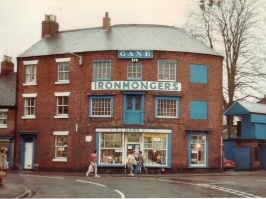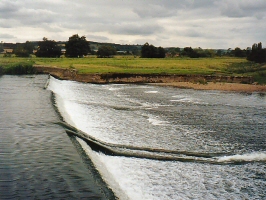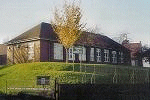Two Walks for Visitors
1. A historical walk through the Village
2. A waterside walk around the Village
The Historical Walk - From an old article by Aubrey Bailey
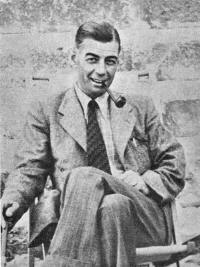
I am quite sure the average visitor's first call would be to the Castle and the Priory Church. Much has been written about these monuments to ancient Saxon and Norman times, so we would refer visitors to the Custodian of the Castle, or the Vicar for the time being of The Priory Church of Saint Mary, either would cover these edifices, and are far more qualified than most, to give such visitors, a broader outline of their respective charges.
The more serious student can turn to Mosley, Shaw, Underhill or Edwards for a greater depth of detail.
THE FISHPOND - THE MANOR OF TUTBURY WOODHOUSES -
CASTLE HAYS AND CHAPEL HOUSE FARM.
Leaving the Castle, Church and environs to those previously mentioned, can I suggest a few sites, site names and places which, although written at random, could be put together as a Guide to Visitors. I also trust it will add little more to that which is already known about 'The Burgh about the Castle'.
For instance, we do know that fresh water fish had to be provided for The Lord of the Manor and his entourage, which is why a fishpond was to be found in what is now Wakefield Avenue, situated some 40 yards on the right as we approach from Duke Street, hence Fishpond Lane, but did you know that this pond was fed by clear spring water from one situated in Redhill Lane, opposite the bridle path which leads to Castle Hays.
From the site of the spring, we are able to see the Manor of Tutbury Woodhouses, where the tenant was required to supply the same Lord of the Manor with wooden vessels for use at the Castle. To the left as we look across the fields, we can see Castle Hays, which apart from its famous stud of horses, made and supplied bricks for use on the estate. Again and to our left we can see Chapel House Farm, whose tenant, by agreement with the Lord of the Manor, was required to pay fees of five pounds annually to the Priest in charge of St.Peter's Chapel within the castle courtyard. All these three farms are part of the lands awarded to the Dukes of Lancaster, and are now part of the estate of The Duchy of Lancaster.
THE LYDGATE - BLACKERDITCH - THE PARK PALE - THE PINFOLD
Also from this same site, looking back towards the village, Holts Lane, Ferrers Avenue, Norman Road and Park Pale are before us. This development covers what was once nine acres and the Lydgate, where in the early days after Domesday, the Needwood Foresters assembled prior to their parade to the Priory Church on the day of the Feast of The Assumption.
The Lydgate was the field immediately behind 'Ludgate Farm' once farmed by the Shaw family. Adjoining the Lydgate is Blackerditch, Park Pale and Iron Walls, all sites associated with the Burgh, and should be preserved. Still in the same area, and worthy of a visit is 'The Pinfold' - the site can be found at the bottom of Ashy Lane, or Elms Lane, where it joints Belmot Road, once known as Forest Road.
ANNE MOORE'S COTTAGE - THE CROSS - THE MARKET HALL
If we turn around now, and proceed down Ludgate (Lydgate) Street, we reach the Post Office, famous for its bow frontage. Directly opposite and now being part of the offices of Tutbury Crystal, once Webb Corbett, was Anne Moore's cottage, Anne was infamous for her fasting.
Contrary to general belief, the Cross does not get its name from the crossroads at the junction with High Street, Burton Street and Duke Street, but rather from the Cross which was situated in the centre of this same crossroads at the time of the Needwood Forester's Rally. The Foresters would join ranks with the Choir of the Priory Church before proceeding to that edifice for their annual service. Before leaving the crossroads, and directly opposite the Post Office, was the Market Hall.
THE GUILDHALL - FISHPOND LANE - PEGGER'S REST
The site of the Guildhall was, where now is, the Duke Street car park. Little is known of this building, but in those far off days, practically all organizations had a Guild, like the Guild of Blacksmiths, the Guild of Archers and so on, and were probably the forerunners of present day unions. Moving on into Fishpond Lane, mentioned earlier, and of interest to those who hunt game or conies, legally or illegally, take a look at 'Pegger's Rest', the home of Joey Hood and his Merry Men. This is now Number 14 Fishpond Lane.
THE WOOLPACK - THE SILK MILL - TOMMY HOLT'S COTTAGE –
HOBY PARKER'S COTTAGE
Back into Duke Street and on into Silk Mill Lane, was once the Woolpack a well known place for drinking, and the one time home of Tommy Mills and family, founder of Tutbury's first bus service. Just around the corner we find the Old Silk Mill, below which were four cottages. The Mill is now completely renovated and restored and is where Georgian Crystal operates. Opposite the Silk Mill was, and still is, Tom and Granny Holt's cottage, after whom Holts Lane was named.
Still on cottages, who remembers Hoby Parker's cottage, next to the Church School and now number 4 Church Street? Hoby's is worthy of mention, for Hoby's wife was none other than Joey Hood's sister. Hoby himself was a great character, very well known and respected locally, and a member of Tutbury Silver Prize Bard when at its height.
SALVATION ARMY - CHAS OWEN, BUILDER - CHARITY SCHOOL -
J.H. GRICE & CO
If we pop down Church Lane (actually part of Church Street), and on into Monk Street, facing us would have been a lane running towards High Street, and down which was the old band room and the home of Tutbury's Salvation Army. Walter Radford had a paint and ladder store down there as well. Close by, number 60 Monk Street was the place of business of Charles Owen, Master Builder, very well respected in the village and one time organist at the Priory Church. Further evidence of these old roads or alleys can be seen at the rear of number 51 Monk Street and at the rear of Castle Garage.
Number 63 Monk Street was Tutbury's first Charity School under the Will of the late Richard Wakefield. Immediately above the shop door entrance, alas now covered up, is a plaque commemorating its foundation.
Opposite the old school were the workshops of J. H. Grice & Co. who also in those far off days, would build anything from a wheelbarrow to a Staffordshire Haywain. Many's the time I have watched the men doing the hooping from an open fire in the yard; by hooping I mean sweating iron hoops or rims on to cart wheels. The Company was later taken over by Mr.J.H. Cooke, specializing in Funeral Directing with it's own Chapel of Rest.
TUTBURY SKINYARD - GOULD'S YARD
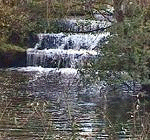 Tutbury's
original skinyard - long before E.B.Chapman and family came to the Cornmill,
was in Bridge Street, the site was to become the Brookside Engineering Company.
Skins were processed, then washed in the clear waters of the Fleam before
being stretched out to dry. The system was very primitive by today’s
standards, but effective none the less, and provided good feed for the fish
lower down stream.
Tutbury's
original skinyard - long before E.B.Chapman and family came to the Cornmill,
was in Bridge Street, the site was to become the Brookside Engineering Company.
Skins were processed, then washed in the clear waters of the Fleam before
being stretched out to dry. The system was very primitive by today’s
standards, but effective none the less, and provided good feed for the fish
lower down stream.
Directly opposite across Bridge Street, was a thriving builders and joinery business owned by a Mr.Gould.
MILLS - GLASS - PUBS - BRIDGES
A little earlier on I mentioned Mr.E.B.Chapman, which brings me once again to the Tutbury Mills, I know that much has been written about all three, but did you know that at one time there were four, at one time all owned by the Bott family. There were two at the Cornmill, known as the Mills of Schotwood, the second one, alas has disappeared. I am given to understand it was situated a little beyond the present one, by Hoblands and Piper's meadow. So to the interested visitor, and maybe some within the parish, it can be said that the oldest Mill by far would be the Cornmill, followed by the Silk Mill, the Cotton Mill and later the Plaster Mill.
Glass, for which Tutbury has been famous for well over 150 years, is still manufactured, and really is a subject unto itself. However, the old works of Webb, Corbett became Tutbury Crystal and are now demolished. Georgian Crystal, founded as a co-operative after the closure of Webb, Corbett, now flourishes at the restyled Silk Mill; visitors are very welcome at either or both factories, where they are able to see for themselves, the process of manufacture, and also purchase the piece of their choice.
About pubs and places for drinking. Visitors may well ask, how is it that in the 18th and 19th centuries, Tutbury had 17 of these favourite drinking places to cater for a population of between one and two thousand souls, yet today, with a population heading for five thousand, we only have five. I make no comment. Before leaving pubs, I would like to point out to visitors, the stabling behind the card shop, once the Queen's Head and one time business of Thomas Mayers the Official Carrier between Tutbury and Burton on Trent.
Much has also been written about the Tutbury Bridges, most of these can still be visited, but I would like visitors to see for themselves, just where the first bridge over the River Dove was situated. Remains of the wooden structure can still be seen at low water, some 250 yards above the present main road bridge. Then, whilst standing on the main road bridge, why not glance towards Marston on Dove, and note the two spots where the Treasure was found in the river Dove way back in 1831.
WELLS - BAKERIES - SCHOOLS
Most visitors to any parish are interested in wells or the supply of water, and I am sure Tutbury would interest most, for there are quite a number within the Burgh, some well known, some not quite so well known, but in my opinion, all worthy of a Well Dressing Ceremony, and why not? If we take the most important in those far off days, surely it must be the one within the Castle Courtyard. Secondly, and also of great importance would be the one by the Old Cock Inn, this was the Village Pump. A few that could be pointed out to the visitors would be the one in Ludgate Street, in a wall cut in just above the works of Tutbury Crystal. There was another one in Castle Street in a stone wall immediately above number 13. There was, and still is, one beneath the floor of the Congregational Church Sunday School; the pump can still be seen just outside the Sunday School door. There were possibly two in Goulds Yard, now completely filled in, and a very deep well in the yard of Manor Farm. I believe, but cannot confirm, that there was one at the old Pumping Station in Cornmill Lane, that is at the bottom of Millway Baulk.
There were four bakeries in the village around the turn of the century, one in Monk Street, belonging to Collingtons, once at number 18 and now part of the site of the new Community Centre. There was one at number 16 High Street, belonging to a Mr.Young. One at the rear of what is now the clock shop being part of the Grocery and Provision business of Mr.O.J.Parrick. Finally there was one at the rear of the Post Office and this was in use until the time or the Taverners, part of the ovens still remain in the art shop.
SCHOOLS ABOUT THE WARREN - ARTIFICIAL FLY TYING
The original Charity School was in Monk Street, then there were the Church Schools, actually in Church Street, later referred to as the Tutbury Girls and Infants School which closed its doors in 1909.
There was the Richard Wakefield Endowed Boys' School in Cornmill Lane 1886-1968.
The more modern Tutbury Girls and Infants School, later Tutbury Secondary Modern, 1909-1968.
All are worth a visit, and of course there were a number of private schools, often advertised as "Private Schools for Young Ladies of Quality". To name most, there was Ashleigh House in High Street, run by Miss Ainger, and later the Misses Richardson, there was one at the Warren, also in High Street run by the Misses Parrick, sisters of George Parrick, the first Headmaster of the Endowed Boys' School. In Duke Street, there was Durham House, now Croft House which was run by the Grice family. This school later removed to Castle Street, at the Manse, one time home of the Congregational Church Minister, and now number 28, Castle Street.
Before leaving the subject of schools, I would like to go back to the Warren in High Street, and explain just how this property came to be named 'The Warren'. Oddly enough, I had to be told by two visiting American doctors, they were able to tell me that the Warren was built by a Doctor Warren, a Fellow of the Royal College of Surgeons, who decided upon the name as a constant reminder and memorial to the many happy days spent in this village.
I have written about artificial fly tying elsewhere, the Company formed by Roger Woolley flourished at number 3 Bridge Street. Visitors were able to see for themselves how the lure was made, this is a very interesting cottage industry which exported many of its 'Specials'.
NONCONFORMITY - THE TUTBURY CHARITIES - THE OLD SOUP HOUSE
I am sure there would be visitors who would be interested in Non Conformity, so here is a reminder of sites, names and places. The first Nonconformist Church was in Castle Street, being the Primitive Methodist, famous for the visit of Dinah Morris the well known Evangelist. This church later removed to Cornmill Lane and is now number 6a. Then there was the Wesleyan Chapel in High Street, and of course the Congregational Church in Monk Street. All have been written about elsewhere, but the sites or buildings can still be seen.
Last, but by no means least, we come to the Charity Office in Duke Street, the home of the Trustees of the Tutbury Parish Charities, and known locally as the 'Soup House'. Much has also been written about Richard Wakefield, his Will and his Pedigree, let it be sufficient to say that interested visitors to the village, can call in at the Soup House and see plenty of historical witness to a very interesting past. I would also like to remind visitors, that Richard Wakefield built and maintained four almshouses in Castle Street, numbers 7 to 10, which regretfully had to be pulled down in 1965/66 to make way for more modern properties. Hillside Bungalows for the elderly, now covers the site.
I know that most of what I have written, has previously been written about, discussed and quoted, my sole object in bringing them to light again, is in the hope that someone much younger than I, might care to put them in some sort of order, possibly mark some of the places and sites, and so be able to point out to visitors, evidence of Tutbury's very interesting past. We all agree that there is a greater awareness today than ever before, not only to remember, but record and preserve, that which has gone before.
ABOUT 'THE DUMP' AND THE TUTBURY JINNY
Just outside the boundaries of this parish, but nevertheless a part of its history, are two places worthy of a visit. The first, and of great importance to all who remember the catastrophe of 27th November 1944, when 4,000 tons of high explosive, blasted open a crater 250 yards across. The site of the crater is about half a mile to the south west of the Gypsum mines at Fauld, or some three quarters of a mile from the village of Hanbury. The approach from Fauld is through the works' yard and wood beyond. A footpath will lead you there, and from Hanbury, it is over a style by the side of the Cock Inn. Visitors will be able to see the size of the crater, for it is almost impossible to visualise from reading records, perhaps they will also spare a thought for the relatives of those whose bodies were never recovered.
The second site I recommend, is just over the border into Derbyshire, where once was a busy and thriving railway, passenger and goods station. To the railway enthusiast, I donate these few words. The 'Tutbury Jinny' was a passenger train which ferried passengers between Tutbury, via Rolleston on Dove, Stretton, Claymills and Horninglow to Burton on Trent, and of course in the opposite direction. A Memorial would read TUTBURY JINNY, born 1849 died 1960. Here are a few more details connected with the founding of the route. Like many other projects inaugurated in the early days, the complete picture does not emerge until research established the facts, my research led me to Mr.Peter Rowbotham of British Rail, who both knew and remembered.
It seems that The North Staffordshire Railway Company was given the necessary authority to open up some 12½ miles of rail from Uttoxeter to Burton upon Trent. The contract was awarded to Messrs Earl & Combe who commenced work on the project in the summer of 1847, and completed it on the 11th September 1848. The line was actually opened to passenger and goods traffic on that date, but the 4½ miles from Marston Junction to Willington Junction was not opened until the 13th July 1949, but was closed down along with three other intermediate stations, Rolleston and Stretton in the year 1949.
In 1960 it was calculated that "the Tutbury Jinny carried an average of twelve passengers per trip, and lost the staggering sum, in those days, of £7,000 a year. Therefore it came as no surprise when the authorities ordered a complete closure of the line and the junctions, Tutbury, Stretton and Egginton. The one at Horninglow closed two years earlier.
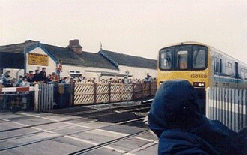 The
old line is now a public footpath.
The
old line is now a public footpath.
This picture shows the first stopping train when the station was re-opened as 'Tutbury and Hatton' in 1989.
The line now runs through Uttoxeter and Derby but unfortunately not to Burton.


